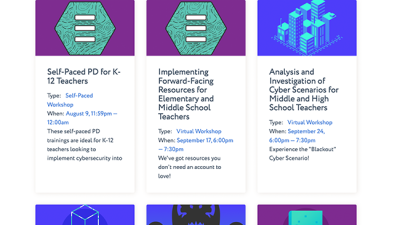Project Access
In June, we launched Project Access, a program designed to expand access to cybersecurity education for blind and vision-impaired students between the ages of 13-21 who are in pre-employment transition (Pre-ETS). CYBER.ORG pioneered a series of camps this past summer in Arkansas, Maine, Virginia and Michigan to introduce these students to key cybersecurity topics, help them develop cybersecurity skills, and explore the possibility of pursuing a career in a growing industry.
CYBER.ORG piloted the program in 2017 in collaboration with Virginia’s Department for the Blind and Vision Impaired (DBVI) to develop blind and vision-impaired accessible curriculum that educators could use to teach cybersecurity and help students build confidence in the field. Virginia’s DBVI programming has resulted in 94% of participating students planning to study cybersecurity in college, pursue cybersecurity credentials or directly enter the cybersecurity workforce.
As the first dedicated program to teach blind and visually impaired students cybersecurity, CYBER.ORG plans to expand the program to include K-12 neurodivergent students in the coming year.
Project REACH
Launched in September, Project REACH (Realizing Equitable Access to Cybersecurity in High School) is a feeder program for Historically Black Colleges and Universities (HBCUs), Minority Serving Institutes (MSIs), and Hispanic Serving Institutes (HSIs) created to diversify and bolster the U.S. cybersecurity workforce. CYBER.ORG connects K-12 students with HBCUs, MSIs, and HSIs that have cybersecurity and computer science programs to foster critical conversations about entering the cybersecurity workforce. CYBER.ORG also provides key curriculum resources that are culturally relevant to minority students. In addition, educators at our partner schools get access to professional development and resources through CYBER.ORG, which includes the opportunity to get involved in mentorship and internship programs for both high school and college students.
Expanded to 10 additional HBCUs nationwide, the growth of Project REACH comes on the heels of a successful pilot program at Grambling State University funded through at $250,000 grant from the National Security Agency (NSA). The pilot integrated state-approved curricula into Huntington High School and Southwood High School’s course offerings.
The rapid growth of Project REACH is helping improve student cybersecurity literacy nationwide and providing high school students with increased access to cybersecurity education, resources to grow their cybersecurity skills, and opportunities to pursue mentorships and careers in the field.
Closing the cybersecurity workforce gap and improving diversity in the field requires all students to become cyber-literate. Cybersecurity education needs more than a “one size fits all” approach. Our goal is to create equitable cybersecurity education for every student nationwide, and we’re excited to continue building a diverse pipeline of future cybersecurity professionals and revitalizing this crucial industry.




